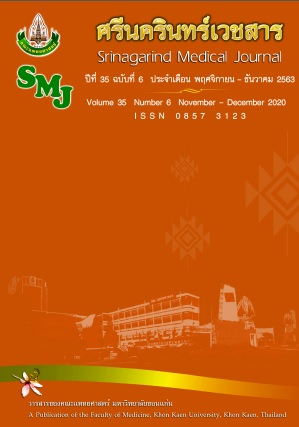Development of Reusable Hot and Cold Pack Made from Clay
Keywords:
Hot and cold packs; Clay; Heat therapy; Cold therapyAbstract
Background and objectives: Reusable heat and cold treatment devices have a difficult disinfecting prองศาเซลเซียสedure. This study investigated the effectiveness of reusable hot and cold packs made from clay on temperatures storage and transfer property. The benefit of this study may be used as an alternative option to heat and cold treatment devices.
Method: Developing heat and cold pack from clay packed into vacuum bags and testing the heat and cold preservation properties and test the skin temperature during the heat and cold compress for 20 minutes.
Results: From a pilot study, it was found that the hot and cold packs, size 25 x 20 cm, made from clay, weight 500 grams, it has temperatures storage property for more than 20 minutes. The average skin temperature increased to a maximum of 44.0 ± 1.3oC and reduced to 41.6 ± 0.2 oC after 20 minutes. Cold compresses, the average skin temperature dropped to the lowest at 22.7 ± 0.1 oC, it was increased to 23.4 ± 0.1 oC after 20 minutes of cold compresses.
Conclusion: This study demonstrated the effectiveness of heat and cold packs made from clay. Based on physiological effects, it can be used as a treatment to promote hot and cold effects. This may be used as an alternative option for effectively heat and cold treatment.
References
2. Kritmanorot J. Herbal hot pack development for musculoskeletal patients. J Thai Trad Alt Med 2551; 6: 18-22.
3. Nichapa P, Chamon T. Immediate effects of Thai herbal hot pack treatment on pain and lower back flexibility: a pilot study. J Health Sci Med Res 2017; 35(3): 221-228.
4. Kanlayanaphotporn P, Janwantanakul P. Comparison of skin surface temperature during the application of various cryotherapy modalities. Arch Phys Med Rehab 2005; 86(7): 1411-1415.
5. Janwantanakul P. Cold pack/skin interface temperature during ice treatment with various levels of compression. Physiotherapy 2006; 92(4): 254-259.
6. Janwantanakul P. The effect of quantity of ice and size of contact area on ice pack/skin interface temperature. Physiotherapy 2009; 95(2): 120-125.
7. กันยา ปาละวิวัธน์. การรักษาด้วยเครื่องไฟฟ้าทางกายภาพบําบัด. กรุงเทพ: บริษัทสํานักพิมพ์เดอะบุคส์จํากัด 2543; 260-294.
8. สุนารี บดีพงศ์, ปิยะ ผ่านศึก, อภิญญา ศุกลรัตน์. การศึกษาสมบัติทางแร่วิทยา องค์ประกอบทางเคมี และสมบัติกายภาพของดินเหนียว จากแหล่งผลิตเครื่องปั้นดินเผาบ้านชุนชงโรงอ่าง จังหวัดปัตตานี, วารสารวิจัยราชมงคลกรุงเทพ 2562; 13(1): 17-29.
9. Mun JH, Jeon JH, Jung YJ, Jang KU, Yang HT, Lim HJ, et al. The factors assองศาเซลเซียสiated with contact burns from therapeutic modalities. Ann Rehabil Med 2012; 36: 688-695.
10. เสาวนีย์ เหลืองอร่าม, โอปอร์ วีรพันธุ์. ผลของระยะเวลาต้มในน้ําร้อนต่อประสิทธิภาพของแผ่นร้อน ,วารสารเทคนิคการแพทย์และกายภาพบําบัด ขอนแก่น 2559; 28(3): 300-308.




